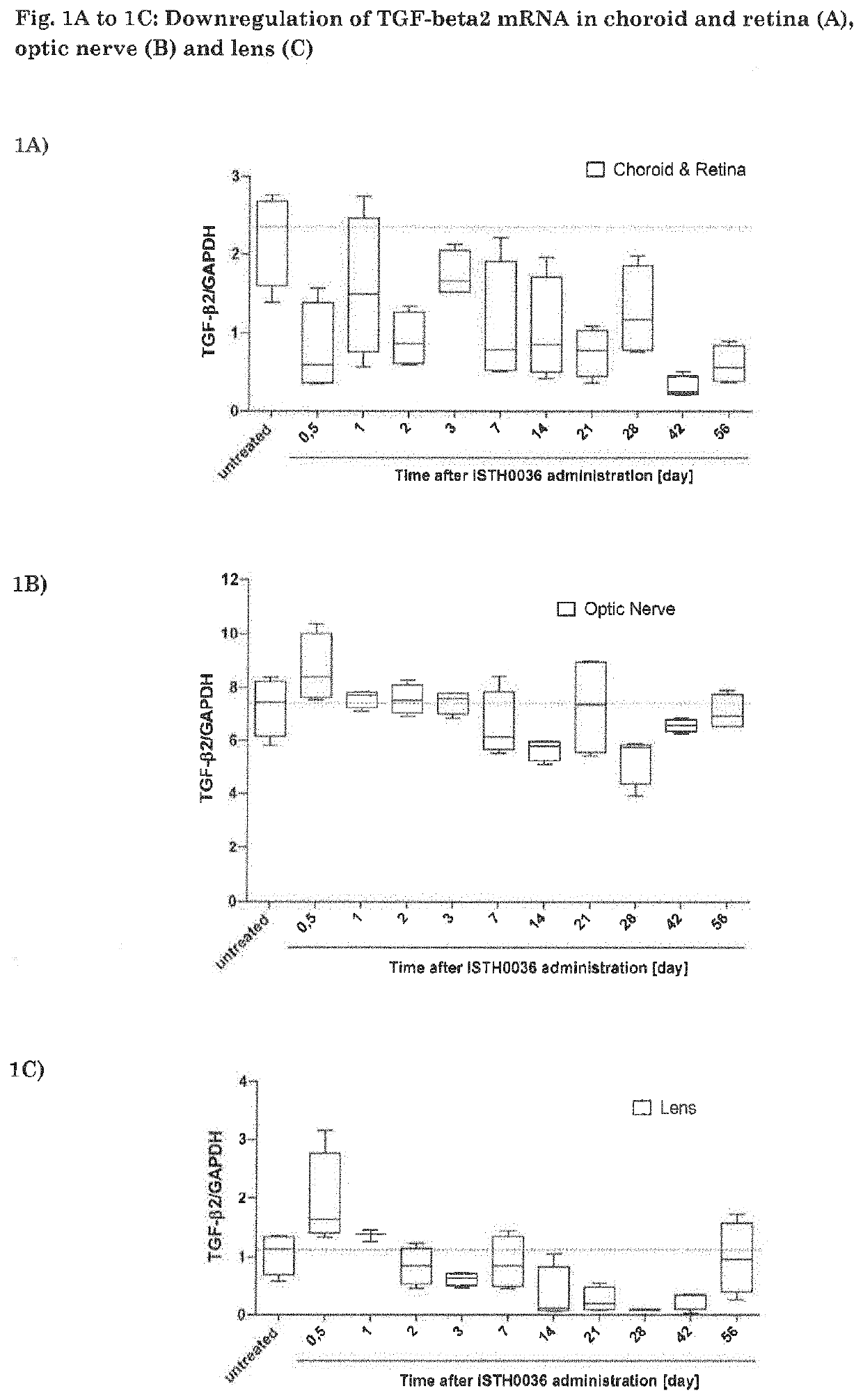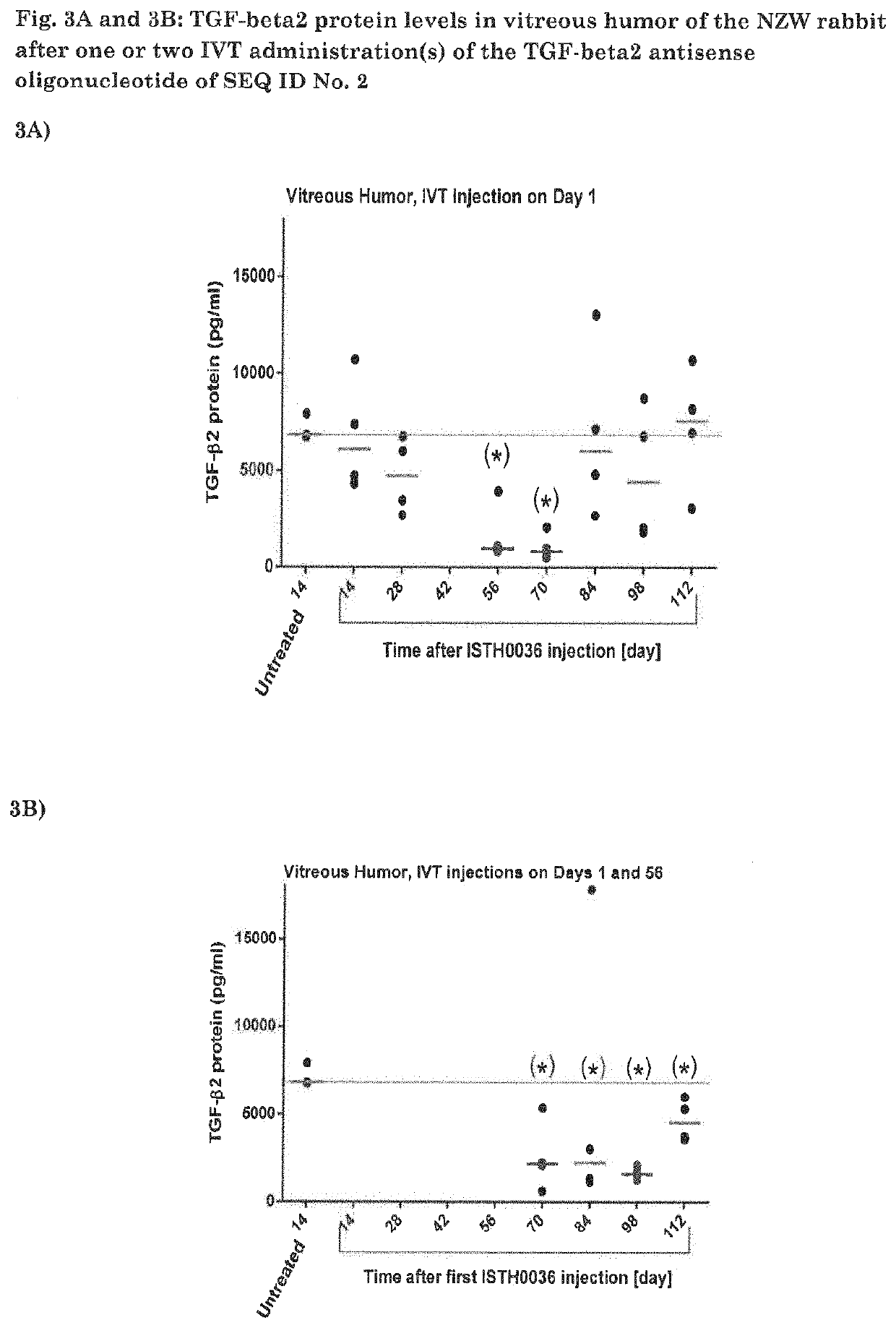TGF-beta oligonucleotide for use in treatment of ophthalmic diseases
a technology of oligonucleotide and ophthalmic disease, which is applied in the direction of biochemistry apparatus and processes, surgical drugs, drug compositions, etc., can solve the problems of -dependent signaling, insufficient pharmacokinetic properties and suboptimal affinity to qualify as proper therapeutic drugs, and permanent degeneration of the ey
- Summary
- Abstract
- Description
- Claims
- Application Information
AI Technical Summary
Benefits of technology
Problems solved by technology
Method used
Image
Examples
example 1
ation of TGF-Beta2 mRNA in Choroid and Retina (A), Optic Nerve (B) and Lens (C)
[0075]Target mRNA (TGF-beta2) expression was analyzed—after single IVT injection of ISTH0036 in both eyes (191 μg; 50 μL per eye, in order to achieve an approximate final test item concentration of 30 μM in the vitreous humor) of NZW rabbits—in choroid and retina (FIG. 1A), optic nerve (FIG. 1B) and lens (FIG. 1C). IVT injections were performed on day 0 and animals (2 animals per group) were sacrificed at the indicated times. All ocular tissues (both anterior and posterior) were dissected and immediately snap frozen for further analysis of target mRNA downregulation and tissue drug concentration. TGF-beta2 mRNA levels were quantified and normalized to corresponding GAPDH mRNA values. Data are represented as box plots, in which median values (line), upper and lower quartiles, and 90th and 10th percentiles are indicated. Both aqueous and vitreous humor, as well as anterior (cornea and lens) and posterior (i...
example 2
mRNA Expression in Retina and Choroid Tissues of the NZW Rabbit after One or Two IVT Administration(s) of an Antisense Oligonucleotide of SEQ ID No. 1 (ISTH0036)
[0076]ISTH0036 (200 μg / 50 μL) was administered in NZW rabbit eyes via a single (Day 1; FIG. 2A) or two (Days 1 and 56; FIG. 2B) IVT injection(s). The test item was injected in both eyes of the animals, 2 animals per time point were sacrificed on Days 14, 28, 56, 70, 84 96 and 112 of Group 2 and 2 animals on Day 70, 84, 96 and 112 of Group 3 (n=4 eyes). Retina and choroid were dissected and immediately snap frozen for further analysis of target mRNA downregulation. TGF-beta2 mRNA levels were quantified by bDNA assay and results were normalized to GAPDH values. Data are represented as box plots, in which median values (line), upper and lower quartiles, and min and max values are indicated. (*) p<0.05 compared to untreated (2-sided p values). Statistical significance was analyzed using non-parametric 2-independent samples Wilco...
example 3
Protein Levels In Vitreous Humor of the NZW Rabbit after One or Two IVT Administration(s) of an Antisense Oligonucleotide of SEQ ID No. 1 (ISTH0036)
[0078]ISTH0036 (200 μg / 50 μL) was administered in NZW rabbit eyes via IVT injection. The test item was injected in both eyes of the animals. Vitreous humor was collected on the indicated Days (n=4 eyes) and immediately snap frozen for further analysis of TGF-beta2 protein concentration. Protein levels were determined by multiplex analysis. Data are represented as individual dot plots and median values (red lines) are indicated. (*) p<0.05 compared to untreated (2-sided p values). Statistical significance was analyzed using non-parametric 2-independent samples Wilcoxon-Mann Whitney test.
[0079]FIG. 3 shows long-lasting TGF-beta2 protein reduction (with return to baseline on Day 84) in the vitreous humor after a single IVT administration of ISTH0036, suggesting full target (protein) engagement on Days 56 and 70 after single IVT administrati...
PUM
| Property | Measurement | Unit |
|---|---|---|
| volume | aaaaa | aaaaa |
| concentrations | aaaaa | aaaaa |
| nucleic acid | aaaaa | aaaaa |
Abstract
Description
Claims
Application Information
 Login to View More
Login to View More - R&D
- Intellectual Property
- Life Sciences
- Materials
- Tech Scout
- Unparalleled Data Quality
- Higher Quality Content
- 60% Fewer Hallucinations
Browse by: Latest US Patents, China's latest patents, Technical Efficacy Thesaurus, Application Domain, Technology Topic, Popular Technical Reports.
© 2025 PatSnap. All rights reserved.Legal|Privacy policy|Modern Slavery Act Transparency Statement|Sitemap|About US| Contact US: help@patsnap.com



